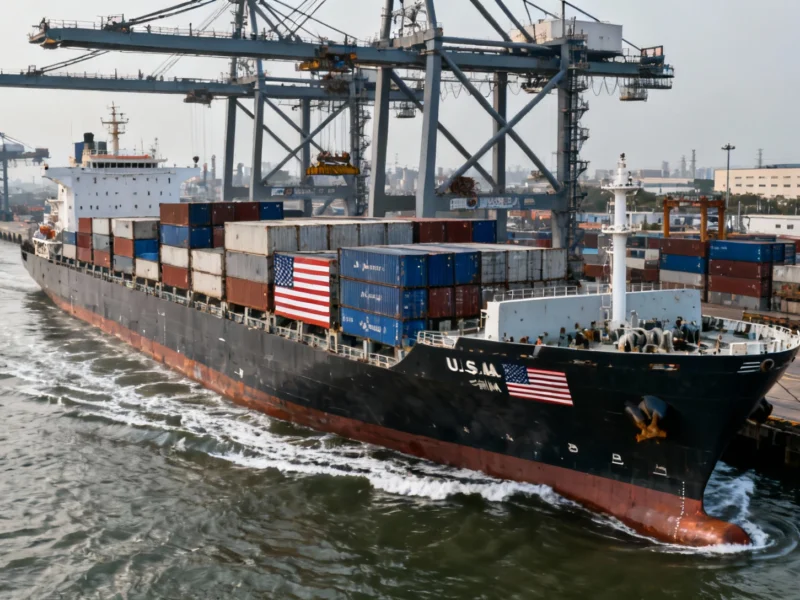In a significant escalation of trade tensions, China has imposed retaliatory port fees specifically targeting U.S.-owned and operated vessels docking in Chinese ports. The move comes as a direct response to planned American port fees on Chinese ships, creating a tit-for-tat economic confrontation between the world’s two largest economies. The timing is particularly significant, with the measures taking effect just weeks before an anticipated meeting between U.S. President Donald Trump and Chinese leader Xi Jinping at the Asia-Pacific Economic Cooperation forum.
Details of China’s Retaliatory Port Fees
The Chinese Ministry of Transport announced on Friday that vessels owned or operated by American companies or individuals, as well as ships built in the United States or flying the American flag, will now face special fees when docking at any Chinese port. The specific charges amount to 400 yuan (approximately $56) per net ton for each voyage to China. This mirrors the structure of the U.S. fees that prompted China’s response, though the specific amounts and escalation timelines differ between the two nations’ measures.
According to the ministry’s detailed announcement, the fees will apply to the same vessel for a maximum of five voyages annually. More concerning for shipping companies, the charges are scheduled to increase progressively each year through 2028, when they will reach 1,120 yuan ($157) per net ton. The implementation date of October 14 coincides exactly with when the United States plans to begin imposing its own port fees on Chinese vessels, creating a synchronized escalation in trade measures.
Official Justification and Diplomatic Context
China’s transport ministry explicitly characterized the new fees as “countermeasures” against what it termed “wrongful” U.S. practices. In an official statement, the ministry strongly criticized the American port fees as “discriminatory” measures that would “severely damage the legitimate interests of China’s shipping industry” and “seriously undermine” the established international economic and trade order. This language reflects the increasingly confrontational tone in trade discussions between the two economic powers.
The timing of these measures is particularly noteworthy given the broader context of U.S.-China relations. As global economic policies shift and nations adjust their trade strategies, these port fee escalations represent another front in the ongoing economic competition. The measures come amid what analysts describe as a broader realignment of global economic relationships, with nations increasingly taking protective measures for their domestic industries.
Comparison with U.S. Port Fee Structure
The symmetry between China’s retaliatory measures and the original U.S. plans is striking. Under Washington’s proposed fee structure, Chinese-owned or operated vessels would face charges of $50 per net ton for each voyage to American ports. Similar to China’s approach, the U.S. fees would increase by $30 per net ton annually until 2028, with the same five-voyage annual maximum per vessel. This mirroring of fee structures suggests both nations are carefully calibrating their responses to maintain proportionality while still delivering economic impact.
The parallel escalation mechanisms in both countries’ fee schedules create a predictable but concerning trajectory for shipping costs through the remainder of the decade. Shipping industry analysts warn that these accumulating costs could ultimately be passed along to consumers through higher prices for imported goods, potentially affecting everything from entertainment and media services to electronics and automated design equipment that rely on global supply chains.
Broader Trade Measures and Strategic Implications
These port fee announcements represent just one element in a series of recent trade measures from Beijing. Earlier in the week, China unveiled new restrictions on exports of rare earth elements and related technologies, along with additional controls on lithium battery and production equipment exports. These moves target sectors where China holds significant global market share, giving them substantial leverage in trade negotiations.
The cumulative effect of these measures suggests a coordinated strategy ahead of the anticipated Trump-Xi meeting. As both nations position themselves for negotiations, the economic tools being deployed extend beyond traditional tariff disputes to include more targeted industrial and technological restrictions. This approach reflects the evolving nature of technology governance and economic competition in an increasingly digital global economy.
Industry Impact and Global Trade Implications
Shipping industry representatives have expressed concern about the cumulative impact of these reciprocal fees. While the per-ton charges might appear modest individually, the annual increases and multi-year duration could significantly impact operating costs for vessels frequently traveling between U.S. and Chinese ports. The maximum five voyages per year provision creates particular complications for regularly scheduled container services and bulk carriers with established routes.
The broader implications for global trade patterns are equally significant. As the world’s largest trading nation and second-largest economy, China’s trade policies inevitably influence global shipping routes and supply chain decisions. These escalating fees could accelerate trends toward regionalization of trade and diversification of supply sources that began during earlier phases of the U.S.-China trade disputes.
Looking Ahead: Diplomatic Resolution Prospects
With the fees scheduled to take effect in October, attention now turns to whether diplomatic channels can produce a resolution before full implementation. The upcoming APEC meeting provides a natural venue for direct discussions between Presidents Trump and Xi, though both sides appear to be strengthening their negotiating positions in advance. The synchronized timing of the fee implementations suggests both nations want to maintain negotiating leverage while avoiding being the first to escalate.
The coming weeks will reveal whether these measures represent opening positions in a negotiation or the beginning of another prolonged trade dispute phase. What remains clear is that the economic relationship between the United States and China continues to evolve in ways that will shape global trade patterns for years to come, with these port fees representing just the latest manifestation of that ongoing transformation.



